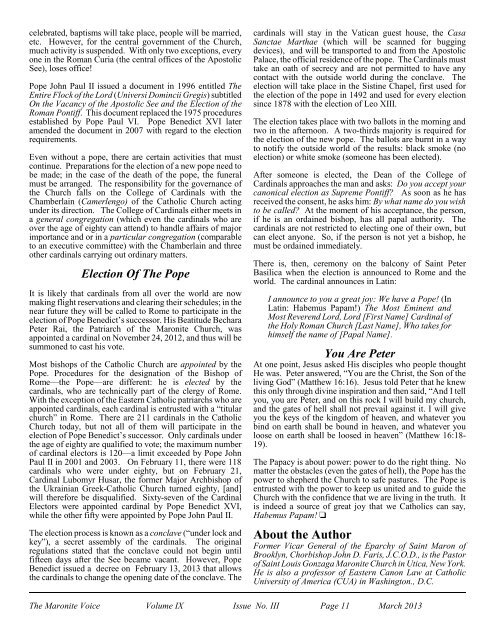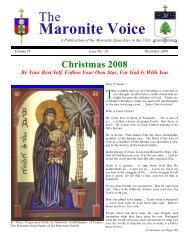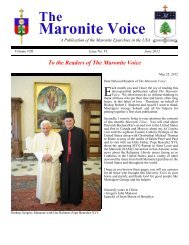March 2013 - Eparchy of Saint Maron of Brooklyn
March 2013 - Eparchy of Saint Maron of Brooklyn
March 2013 - Eparchy of Saint Maron of Brooklyn
You also want an ePaper? Increase the reach of your titles
YUMPU automatically turns print PDFs into web optimized ePapers that Google loves.
celebrated, baptisms will take place, people will be married,<br />
etc. However, for the central government <strong>of</strong> the Church,<br />
much activity is suspended. With only two exceptions, every<br />
one in the Roman Curia (the central <strong>of</strong>fices <strong>of</strong> the Apostolic<br />
See), loses <strong>of</strong>fice!<br />
Pope John Paul II issued a document in 1996 entitled The<br />
Entire Flock <strong>of</strong> the Lord (Universi Domincii Gregis) subtitled<br />
On the Vacancy <strong>of</strong> the Apostolic See and the Election <strong>of</strong> the<br />
Roman Pontiff. This document replaced the 1975 procedures<br />
established by Pope Paul VI. Pope Benedict XVI later<br />
amended the document in 2007 with regard to the election<br />
requirements.<br />
Even without a pope, there are certain activities that must<br />
continue. Preparations for the election <strong>of</strong> a new pope need to<br />
be made; in the case <strong>of</strong> the death <strong>of</strong> the pope, the funeral<br />
must be arranged. The responsibility for the governance <strong>of</strong><br />
the Church falls on the College <strong>of</strong> Cardinals with the<br />
Chamberlain (Camerlengo) <strong>of</strong> the Catholic Church acting<br />
under its direction. The College <strong>of</strong> Cardinals either meets in<br />
a general congregation (which even the cardinals who are<br />
over the age <strong>of</strong> eighty can attend) to handle affairs <strong>of</strong> major<br />
importance and or in a particular congregation (comparable<br />
to an executive committee) with the Chamberlain and three<br />
other cardinals carrying out ordinary matters.<br />
Election Of The Pope<br />
It is likely that cardinals from all over the world are now<br />
making flight reservations and clearing their schedules; in the<br />
near future they will be called to Rome to participate in the<br />
election <strong>of</strong> Pope Benedict’s successor. His Beatitude Bechara<br />
Peter Rai, the Patriarch <strong>of</strong> the <strong>Maron</strong>ite Church, was<br />
appointed a cardinal on November 24, 2012, and thus will be<br />
summoned to cast his vote.<br />
Most bishops <strong>of</strong> the Catholic Church are appointed by the<br />
Pope. Procedures for the designation <strong>of</strong> the Bishop <strong>of</strong><br />
Rome—the Pope—are different: he is elected by the<br />
cardinals, who are technically part <strong>of</strong> the clergy <strong>of</strong> Rome.<br />
With the exception <strong>of</strong> the Eastern Catholic patriarchs who are<br />
appointed cardinals, each cardinal is entrusted with a “titular<br />
church” in Rome. There are 211 cardinals in the Catholic<br />
Church today, but not all <strong>of</strong> them will participate in the<br />
election <strong>of</strong> Pope Benedict’s successor. Only cardinals under<br />
the age <strong>of</strong> eighty are qualified to vote; the maximum number<br />
<strong>of</strong> cardinal electors is 120—a limit exceeded by Pope John<br />
Paul II in 2001 and 2003. On February 11, there were 118<br />
cardinals who were under eighty, but on February 21,<br />
Cardinal Lubomyr Husar, the former Major Archbishop <strong>of</strong><br />
the Ukrainian Greek-Catholic Church turned eighty, [and]<br />
will therefore be disqualified. Sixty-seven <strong>of</strong> the Cardinal<br />
Electors were appointed cardinal by Pope Benedict XVI,<br />
while the other fifty were appointed by Pope John Paul II.<br />
The election process is known as a conclave (“under lock and<br />
key”), a secret assembly <strong>of</strong> the cardinals. The original<br />
regulations stated that the conclave could not begin until<br />
fifteen days after the See became vacant. However, Pope<br />
Benedict issued a decree on February 13, <strong>2013</strong> that allows<br />
the cardinals to change the opening date <strong>of</strong> the conclave. The<br />
cardinals will stay in the Vatican guest house, the Casa<br />
Sanctae Marthae (which will be scanned for bugging<br />
devices), and will be transported to and from the Apostolic<br />
Palace, the <strong>of</strong>ficial residence <strong>of</strong> the pope. The Cardinals must<br />
take an oath <strong>of</strong> secrecy and are not permitted to have any<br />
contact with the outside world during the conclave. The<br />
election will take place in the Sistine Chapel, first used for<br />
the election <strong>of</strong> the pope in 1492 and used for every election<br />
since 1878 with the election <strong>of</strong> Leo XIII.<br />
The election takes place with two ballots in the morning and<br />
two in the afternoon. A two-thirds majority is required for<br />
the election <strong>of</strong> the new pope. The ballots are burnt in a way<br />
to notify the outside world <strong>of</strong> the results: black smoke (no<br />
election) or white smoke (someone has been elected).<br />
After someone is elected, the Dean <strong>of</strong> the College <strong>of</strong><br />
Cardinals approaches the man and asks: Do you accept your<br />
canonical election as Supreme Pontiff? As soon as he has<br />
received the consent, he asks him: By what name do you wish<br />
to be called? At the moment <strong>of</strong> his acceptance, the person,<br />
if he is an ordained bishop, has all papal authority. The<br />
cardinals are not restricted to electing one <strong>of</strong> their own, but<br />
can elect anyone. So, if the person is not yet a bishop, he<br />
must be ordained immediately.<br />
There is, then, ceremony on the balcony <strong>of</strong> <strong>Saint</strong> Peter<br />
Basilica when the election is announced to Rome and the<br />
world. The cardinal announces in Latin:<br />
I announce to you a great joy: We have a Pope! (In<br />
Latin: Habemus Papam!) The Most Eminent and<br />
Most Reverend Lord, Lord [First Name] Cardinal <strong>of</strong><br />
the Holy Roman Church [Last Name], Who takes for<br />
himself the name <strong>of</strong> [Papal Name].<br />
You Are Peter<br />
At one point, Jesus asked His disciples who people thought<br />
He was. Peter answered, “You are the Christ, the Son <strong>of</strong> the<br />
living God” (Matthew 16:16). Jesus told Peter that he knew<br />
this only through divine inspiration and then said, “And I tell<br />
you, you are Peter, and on this rock I will build my church,<br />
and the gates <strong>of</strong> hell shall not prevail against it. I will give<br />
you the keys <strong>of</strong> the kingdom <strong>of</strong> heaven, and whatever you<br />
bind on earth shall be bound in heaven, and whatever you<br />
loose on earth shall be loosed in heaven” (Matthew 16:18-<br />
19).<br />
The Papacy is about power: power to do the right thing. No<br />
matter the obstacles (even the gates <strong>of</strong> hell), the Pope has the<br />
power to shepherd the Church to safe pastures. The Pope is<br />
entrusted with the power to keep us united and to guide the<br />
Church with the confidence that we are living in the truth. It<br />
is indeed a source <strong>of</strong> great joy that we Catholics can say,<br />
Habemus Papam! <br />
About the Author<br />
Former Vicar General <strong>of</strong> the <strong>Eparchy</strong> <strong>of</strong> <strong>Saint</strong> <strong>Maron</strong> <strong>of</strong><br />
<strong>Brooklyn</strong>, Chorbishop John D. Faris, J.C.O.D., is the Pastor<br />
<strong>of</strong> <strong>Saint</strong> Louis Gonzaga <strong>Maron</strong>ite Church in Utica, New York.<br />
He is also a pr<strong>of</strong>essor <strong>of</strong> Eastern Canon Law at Catholic<br />
University <strong>of</strong> America (CUA) in Washington., D.C.<br />
The <strong>Maron</strong>ite Voice Volume IX Issue No. III Page 11 <strong>March</strong> <strong>2013</strong>

















